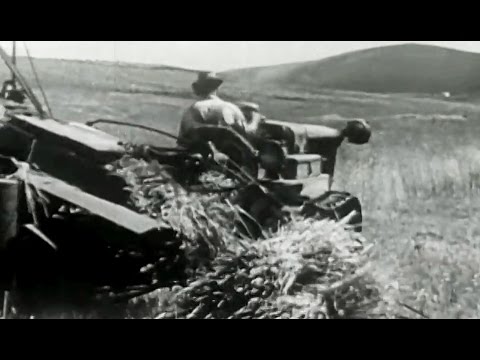more at
Touchy-feely home front film on the importance of farmers and agriculture during World War II, with plenty of church & family.
Public domain film from the Prelinger Archives, slightly cropped to remove uneven edges, with the aspect ratio corrected, and mild video noise reduction applied.
The soundtrack was also processed with volume normalization, noise reduction, clipping reduction, and/or equalization (the resulting sound, though not perfect, is far less noisy than the original).
The United States home front during World War II supported the war effort in many ways, including a wide range of volunteer efforts and submitting to government-managed rationing and price controls. Everyone agreed that the sacrifices were for the national good “for the duration.” The labor market changed radically. Peacetime conflicts with respect to race and labor took on a special dimension because of the pressure for national unity. The Hollywood film industry was important for propaganda. Every aspect of life from politics to personal savings changed when put on a wartime footing. This was achieved by tens of millions of workers moving from low to high productivity jobs in industrial centers. Millions of students, retirees, housewives, and unemployed moved into the active labor force. Hours worked increased as leisure activities declined sharply. Most families were allocated 3 US gallons (11 l; 2.5 imp gal) of gasoline a week, which sharply curtailed driving for any purpose. Production of most durable goods, like cars, new housing, vacuum cleaners, and kitchen appliances, was banned until the war ended. Gasoline, meat, and clothing were tightly rationed. In industrial areas housing was in short supply as people doubled up and lived in cramped quarters. Prices and wages were controlled. Americans saved a high portion of their incomes, which led to renewed growth after the war…
Farming
Labor shortages were felt in agriculture, even though most farmers were given an exemption and few were drafted. Large numbers volunteered or moved to cities for factory jobs. At the same time many agricultural commodities were in greater demand by the military and for the civilian populations of Allies. Production was encouraged and prices and markets were under tight federal control. Civilians were encouraged to create “victory gardens”, farms that were often started in backyards and lots. Children were encouraged to help with these farms, too.
The Bracero Program, a bi-national labor agreement between Mexico and the U.S., started in 1942. Some 290,000 braceros (“strong arms,” in Spanish) were recruited and contracted to work in the agriculture fields. Half went to Texas, and 20% to the Pacific Northwest.
Between 1942 and 1946 some 425,000 Italian and German prisoners of war were used as farm laborers, loggers, and cannery workers. In Michigan, for example, the POWs accounted for more than one-third of the state’s agricultural production and food processing in 1944…

